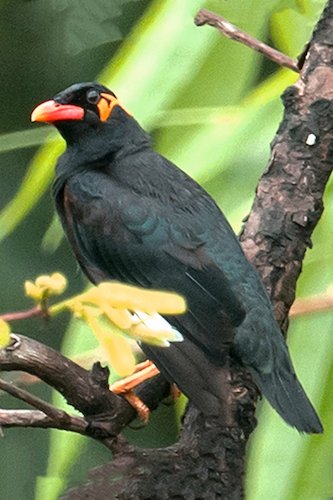Chhattisgarh

Birding Chhattisgarh
Chhattisgarh, a state in central India, formed when the sixteen Chhattisgarhi-speaking southeastern districts of Madhya Pradesh gained statehood on November 1, 2000. Raipur serves as its capital. It is the 10th largest state of India by area of 52,199 sq mi (135,194 km²). Chhattisgarh takes its name from 36 (Chattis is thirty-six in Hindi and Garh is Fort) princely states in this region from very old times, though the listing of these 36 states has always remained a point of dispute.
The north and south parts of the state are hilly, while the central part is a fertile plain. Forests cover roughly forty-four percent of the state.The northern part of the state lies on the edge of the great Indo-Gangetic plain: The Rihand River, a tributary of the Ganges, drains this area. The eastern end of the Satpura Range and the western edge of the Chota Nagpur Plateau form an east-west belt of hills that divide the Mahanadi River basin from the Indo-Gangetic plain.The central part of the state lies in the fertile upper basin of the Mahanadi and its tributaries, with extensive rice cultivation. The upper Mahanadi basin is separated from the upper Narmada basin to the west by the Maikal range, part of the Satpuras, and from the plains of Orissa to the east by ranges of hills.The southern part of the state lies on the Deccan plateau, in the watershed of the Godavari River and its tributary the Indravati River. The Mahanadi is the chief river of the state. Other main rivers are Hasdo (a tributary of Mahanadi), Rihand, Indravati, Jonk and Arpa.
-
Wikipedia
GNU Free Documentation License
http://en.wikipedia.org/wiki/Chhattisgarh
-
Number of bird species: 478
(As at December 2018)State Bird: Hill Myna Gracula religious
-
Fauna of Achanakmar-Amarkantak Biosphere Reserve
(Chhattisgarh and Madhya Pradesh) | By Kailash Chandra | Zoological Survey of India | 2014 | Paperback | 316 pages, 24 plates with colour photos; colour illustrations, colour maps | ISBN: 9788181713773 Buy this book from NHBS.com
-
NP Kanger Ghati
InformationSatellite ViewIt is one of the densest national parks, well known for its biodiversity, landscape, waterfalls, subterranean geomorphologic limestone caves, and home for the Bastar hill myna, the state bird of Chhattisgarh. The avian fauna at the park includes hill myna, spotted owlet, red jungle fowl, racket-tailed drongos, peacocks, parrots, steppe eagles, red spurfowl, phakta, bhura teeter, tree pie and heron among many others. -
NP TR Indravati
InformationSatellite ViewIndravati National Park is a national park located in Bijapur district of Chhattisgarh state, with a total area of approximately 2799.08 km2. The park also gives shelter to the large variety of birds of which the hill myna is the most important species. -
WS BR Achanakmar
InformationSatellite ViewThe Achanakmar Wildlife Sanctuary is an Indian sanctuary in Mungeli district, Chhattisgarh State. Linked by the hilly Kanha-Achanakmar Corridor to the tiger reserve in Kanha, Madhya Pradesh, the sanctuary comprises 557.55 km2 of forest. Tigers and many large mammals as well as a wide variety of birds. -
WS Sitanadi
InformationSatellite ViewSitanadi Wildlife Sanctuary is located in Dhamtari District, Chhattisgarh. This sanctuary sprawls over an area of 556 km2 and has an altitude ranging between 327 and 736 m above the sea level. It is named after Sitanadi River which originates from this sanctuary and joins Mahanadi River near Deokhut. Sitanadi Wildlife Sanctuary is known for its lush green flora and rich and unique and diverse fauna and has great potential to emerge as one of the finest wildlife destinations in central India. -
WS Tamor Pingla
InformationSatellite ViewThe northern boundary is the Moran river, eastern boundary is Bonga Nalla, and western boundary is Rihand River. The area, which is under Tamor, Khond and Pingla Ranges of the Surguja Jashpur Elephant Reserve Forest Division, consists of sal and bamboo forests. Spread over 608.55 km2 (234.96 sq mi), the sanctuary supports Asian elephants, Bengal tigers, Indian leopards, bears, Sambar deer, blue bulls, chital, bison, four-horned antelope, chinkara, barking deer, wild boars, wild dogs, wolves, Golden jackals, Striped hyenas, hare, cobras, nag, pythons, red jungle fowl, brown jungle fowl and green pigeon.

